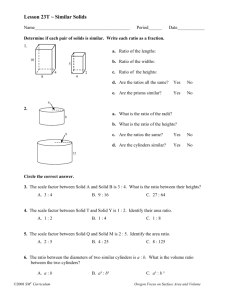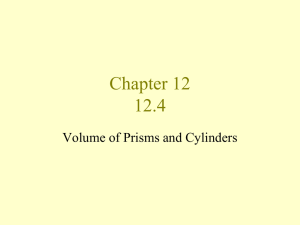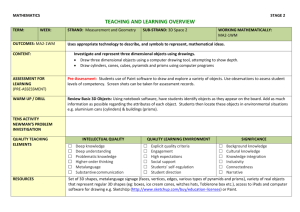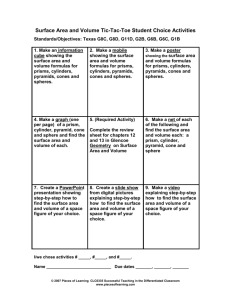Surface Area and Volume
advertisement
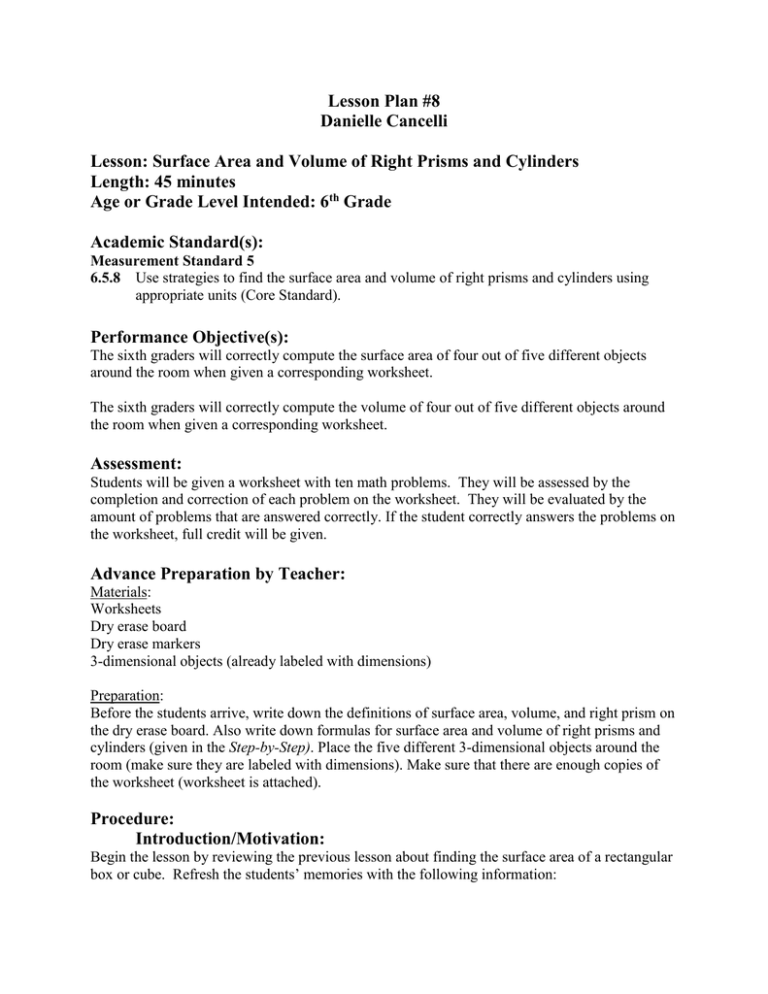
Lesson Plan #8 Danielle Cancelli Lesson: Surface Area and Volume of Right Prisms and Cylinders Length: 45 minutes Age or Grade Level Intended: 6th Grade Academic Standard(s): Measurement Standard 5 6.5.8 Use strategies to find the surface area and volume of right prisms and cylinders using appropriate units (Core Standard). Performance Objective(s): The sixth graders will correctly compute the surface area of four out of five different objects around the room when given a corresponding worksheet. The sixth graders will correctly compute the volume of four out of five different objects around the room when given a corresponding worksheet. Assessment: Students will be given a worksheet with ten math problems. They will be assessed by the completion and correction of each problem on the worksheet. They will be evaluated by the amount of problems that are answered correctly. If the student correctly answers the problems on the worksheet, full credit will be given. Advance Preparation by Teacher: Materials: Worksheets Dry erase board Dry erase markers 3-dimensional objects (already labeled with dimensions) Preparation: Before the students arrive, write down the definitions of surface area, volume, and right prism on the dry erase board. Also write down formulas for surface area and volume of right prisms and cylinders (given in the Step-by-Step). Place the five different 3-dimensional objects around the room (make sure they are labeled with dimensions). Make sure that there are enough copies of the worksheet (worksheet is attached). Procedure: Introduction/Motivation: Begin the lesson by reviewing the previous lesson about finding the surface area of a rectangular box or cube. Refresh the students’ memories with the following information: Definition: The surface area S of a rectangular prism with length l, width w, and height h is the sum of the areas of the faces. Formula: S = 2lw + 2lh + 2wh Explain to the students the difference between surface area and volume (given in the Step-byStep). Answer any questions they may have regarding those problems or the information that you covered. Step-by-Step Plan: 1. Write down the definitions of surface area, volume, and right prism on the dry erase board. Also write down formulas for surface area and volume of right prisms and cylinders (Bloom Level I Knowledge). Surface Area: The total area of the surface of a 3-dimensional object. Volume: The amount of units needed to occupy a space inside of an object. Right Prism: prism with bases aligned one directly above the other and with lateral faces that are rectangles. Surface Area: a. Right Prism: sum of areas of all faces b. Cylinder: sum of areas of the two circular faces and the area of the middle (2πr2 + πrh) Volume: Right Prism: area of base x height Cylinder: area of one of the circular faces x height (πr2 h) 2. Pass out a dry erase board and dry erase marker to each student. Allow the students to work out the examples in the next few steps with you on their dry-erase boards (Bloom Level III Application) (Gardner Spatial). 3. One the board, do a few examples of surface area (Gardner Logical/Mathematical). EX 1: Find the surface area of the rectangular prism with dimensions: l = 2in h = 4in w = 3in 2(2)(3) + 2(2)(4) + 2(3)(4) = 12 + 16 + 24 = 52in2 EX 2: Find the surface area of the triangular prism with dimensions: Base (triangle) dimensions: b = 4in, 2in, 6in h = 6 Height: 4in 2(1/2)(4)(6) + 2(4) + 4(4) + 6(4) = 24 + 8 + 16 + 24 = 72in2 EX 3: Find the surface area of the cylinder with dimensions: r = 5cm h = 4 2π(5)2 + π(5)(4) = 50 π + 20 π = 70 π cm2 4. One the board, do a couple of examples of volume (Gardner Logical/Mathematical). EX 1: Find the volume of the rectangular prism with dimensions: l = 2in h = 4in w = 3in 2(4)(3) = 24in3 EX 2: Find the volume of the triangular prism with dimensions: Base (triangle) dimensions: b = 4in, 2in, 6in h = 6 Height: 4in 1/2(4)(6)(4) = 48in3 EX 3: Find the volume of the cylinder with dimensions: r = 5cm h = 4 π(5)2(4) = 100πcm2 5. Have the students get out a piece of paper and a pencil. They will be doing a writing to learn strategy to help them better understand the content on their own (Bloom Level II Comprehension)(Gardner Intrapersonal). Have them answer the following questions: 1. What is the definition of surface area? 2. What is the formula to find the surface area of a cylinder? 3. What is the definition of volume? 4. What is the formula to find the volume of a cylinder? 5. How do you find the surface area of a right prism and a cylinder? 6. How do you find the volume of a right prism and a cylinder? 6. Allow the students to discuss their answers when everyone is finished. 7. Make sure they understand the concept of finding surface area or volume of right prisms or cylinders (Bloom Level I Knowledge). 8. Ask the class if they have any questions. Answer any questions they may have. 9. Pass out the worksheets to the students and go over the directions with them so they know what is expected. 10. Put the students into groups of two or three and allow them to walk around the room and find the surface area and volume of all of the labeled objects (Gardner Interpersonal). 11. Have the students complete the worksheet problems based on what they have learned and assist those who need help (Bloom Level III Application) (Gardner Logical/Mathematical). Closure: At the end of class, ask the students if they have any questions or need help with understanding how to find surface area or volume of right prisms or cylinders. If they do need help, spend the last amount of class time working with them. If they do not need help, review what the students learned throughout the class by asking them questions (Bloom Level II Comprehension). 1. How do you find the surface area of right prisms and cylinders? 2. How do you find the volume of right prisms and cylinders? Self-Reflection: Was I prepared for the lesson? Were the students engaged? What could I have done to improve the lesson? Did the students easily understand the instructions? Was there enough time given to complete the lesson? Did the students learn from the lesson? Do the students understand the concept of finding surface area and volume of right prisms and cylinders? Adaptations/Enrichment: Mental Retardation: Preparations will be made in order to make sure that the classroom is an open and accepting environment. That way that way the students will comfortable and more willing to learn each day. Instruction may be modified by reducing reading, writing, and language requirements or by simplifying the worksheets. Some students may need a more functional curriculum. In that case the teacher may use a specialized curriculum using domestic skills, leisure skills, and communication. If needed, the teacher may pre-teach the daily routing so that the students know what to expect and what is expected of them. Also, in order to make sure that the students are not being taken advantage of, peer relationships will be monitored. Name __________________________ Surface Area and Volume Directions: Compute the surface area and volume of each labeled, 3-dimensional figure in the room. 1. Surface Area: Volume: 2. Surface Area: Volume: 3. Surface Area: Volume: 4. Surface Area: Volume: 5. Surface Area: Volume:
